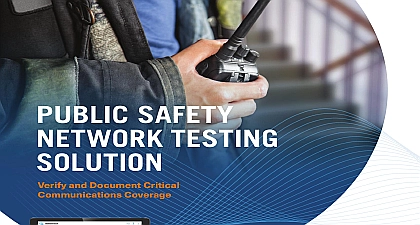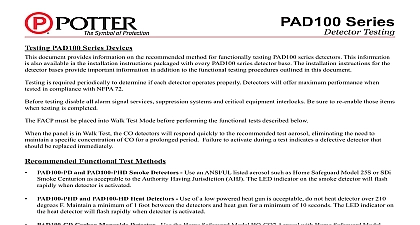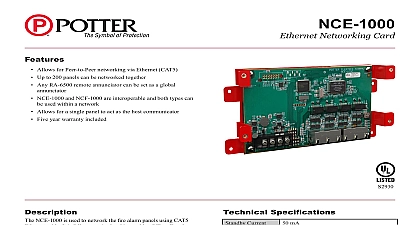Potter PCTEL® IBflex Public Safety Network Testing Solution

File Preview
Click below to download for free
Click below to download for free
File Data
| Name | potter-pctel-ibflex-public-safety-network-testing-solution-3426815097.pdf |
|---|---|
| Type | |
| Size | 1.21 MB |
| Downloads |
Text Preview
IBflex Receiver 10 MHz 6 GHz and Outdoor Network Testing PCTEL IBflex scanning receiver combines portability and accuracy with the power to test multiple and bands simultaneously It can be used to deploy 5G New Radio networks in sub 6 GHz verify public safety coverage optimize dense small cell deployments and improve the reliability IoT systems Low power consumption and a hot swap battery system make the IBflex scanner a tool for a long day of walk testing or interference hunting 5G 3GPP FR1 All existing 2G 3G and 4G CBRS Public safety Wi Fi 2.4 and 5 GHz Other bands currently around the world 5G NR LTE FDD TD LTE NB IoT UMTS GSM CDMA EV DO Wi Fi LAA P25 DMR TETRA Channel Power for additional 4G 5G Dynamic Spectrum Sharing DSS 2x2 and 4x2 LTE MIMO measurements Hot swap battery system Windows laptop and Android support Connect with Bluetooth or USB Blind Scan for automatic detection Specifications New Radio NR modes modes carrier spacing number of channels number of beams channel rate typical range CINR detection level CINR number of PCIs FDD and TD LTE modes modes bandwidths number of channels modes antenna configurations rates range CINR 10 15 20 MHz detection level CINR number of PCIs modes modes mode bandwidths rates range CINR detection level CINR number of PCIs WCDMA HSPA modes modes bandwidths number of channels rate N CPICH dynamic range Ec Io detection level number of Pilots modes modes bandwidths rates range basic detection level TopN Signal Synchronization channels PSS SSS PBCH Blind Scan PSS RP dBm SSS RP dBm PSS RQ dB SSS RQ dB SS CINR dB SSS CINR dB dBm RSPBCH RQ dB RSPBCH CINR dB SSB RP dBm SSB RQ dB dB SSB idx SSB RSSI SSS Delay Spread Time Offset kHz CINR 10 to 33 dB DMRS CINR 8 to 40 dB dBm SCS 15 kHz dB N Synchronization Channel Reference Signal P SCH S SCH and Resource Block Subband Dynamic Spectrum Sharing DSS Layer 3 Reporting Blind Scan Blind Scan RQ CINR Cyclic Prefix Time Offsets Delay Spread RF Path Measurements 4x1 4x2 Condition Number ECQI EPUT 3 5 10 15 20 MHz MIMO 2x2 4x2 2 4 with path measurement FDD 50 sec TD LTE 25 sec to 40 dB to 18 dB dBm RSRP 15 MHz PBCH DMRS Channel RS RS RS N NRS Narrowband Reference Signal NPSS Narrowband Primary Synchronization and NSSS Narrowband Secondary Synchronization Signal Layer 3 Reporting Scan RP RQ RSSI CINR Time Offset NPSS RP RQ RSSI CINR NSSS RP RQ RSSI CINR Offset Guard Band Stand alone kHz to 40 dB dBm dB RP N Pilot Layer 3 Reporting Blind Scan Mobile Blind Scan Ec Io Aggregate Ec Io SIR Rake Finger Count Time Offset Delay Spread kHz 3.84 MHz high speed mode 50 sec high dynamic range mode dB dBm high dynamic range mode dB Code Layer 3 Reporting Blind Scan Mobile Blind Scan C I RSSI kHz 200 kHz to 200 BSIC Decodes sec dB C I dBm dB Specifications and EV DO modes modes bandwidths number of channels rates N PN dynamic range Ec Io PN detection level CINR number of Pilots adapter configuration modes range rates mode mode bandwidth number of channels rate 20MHz 1 Sig range CINR detection level CINR Phase 1 and Phase 2 modes modes bandwidths rate range SINR 1 C4FM and Phase 2 HDQPSK channel rejection modes modes bandwidths rate range SINR modes modes bandwidths rate range SINR channel rejection channel rejection accuracy time tracking N PN CDMA Layer 3 Reporting Blind Scan Mobile Blind Scan lo Ec Io Aggregate Ec Io Pilot Delay Delay Spread kHz 1.25 MHz 25 sec EV DO 18 sec 28 dB EV DO 18.5 dBm 130 dBm EV DO 120 dBm USB 9100 US Asus USB AC56 world or equivalent Strength Noise Level SNR Channel Number Channel Bandwidth BSSID Device Name Security Protocol 802.11 Media Beacon Interval Channel Utilization Throughput 2.483 GHz 5.15 5.85 GHz subject to country regulations typical 5 sec typical for 802.11ac RSRQ RS CINR PSS RQ PSS RP PSS CINR SSS RP SSS RQ SSS CINR MHz dB dBM dB Input CINR 0 dB to 15 dB RSRP RSSI RSSI OOS BER Frame BER Network ID Auto Classification of Phase and Modulation Type kHz Decodes sec maximum 2.7 Decodes sec typical 100 RSSI sec dB minimum detection dB over 8 to 25 dB dB over 3 to 8 dB 25 to 30 dB dB over 118 to 10 dBm dB RSSI RSSI Frame BER kHz Decodes sec maximum 2.7 Decodes sec typical 100 RSSI sec dB minimum detection dB over 6 to 40 dB dB over 3 to 6 dB dB over 118 to 10 dBm dB RSSI RSSI Frame BER Color Code MCC MNC kHz Decodes sec maximum 3.5 Decodes sec typical 100 RSSI sec dB minimum detection dB over 8 to 20 dB dB over 4 to 8 dB dB over 118 to 10 dBm dB channel internal receiver meters start 30 sec Hot start 2 sec dBm Specifications Measurements range channel power examples 5G NR LTE NB IoT UMTS GSM CDMA EV DO 12.5 kHz P25 DMR EDACS Analog LMR 25 kHz TETRA EDACS Analog LMR 125 kHz LoRa 250 kHz LoRa 500 kHz LoRa dB across basic RF input power range to 20 dBm 30 kHz ch sec maximum continguous channels ch sec maximum continguous channels ch sec maximum continguous channels ch sec maximum continguous channels ch sec maximum continguous channels ch sec maximum continguous channels ch sec maximum continguous channels ch sec maximum continguous channels Power Scan EPS analysis power analysis 5 kHz to 20 MHz in 2.5 kHz increments 1,000 MHz sec 5 MHz typical Range 90 dB 270 MHz sec single sweep 1.3 3 5 10 15 20 MHz TD LTE only 20 msec 5 MHz Characteristics range switch


